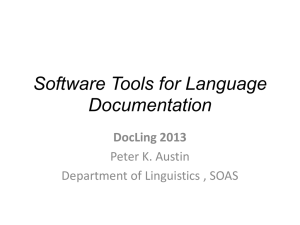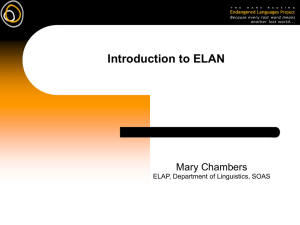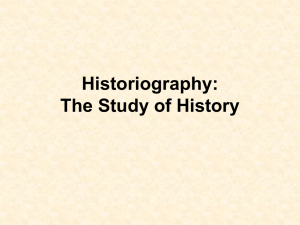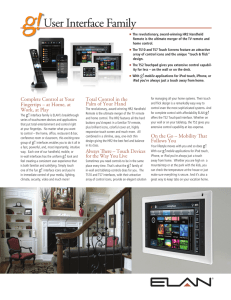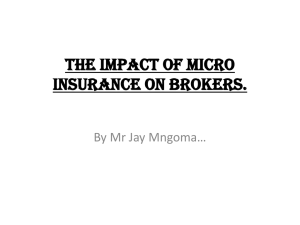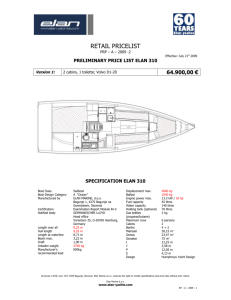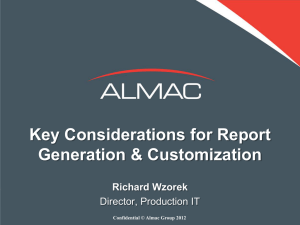Week 1 Software
advertisement
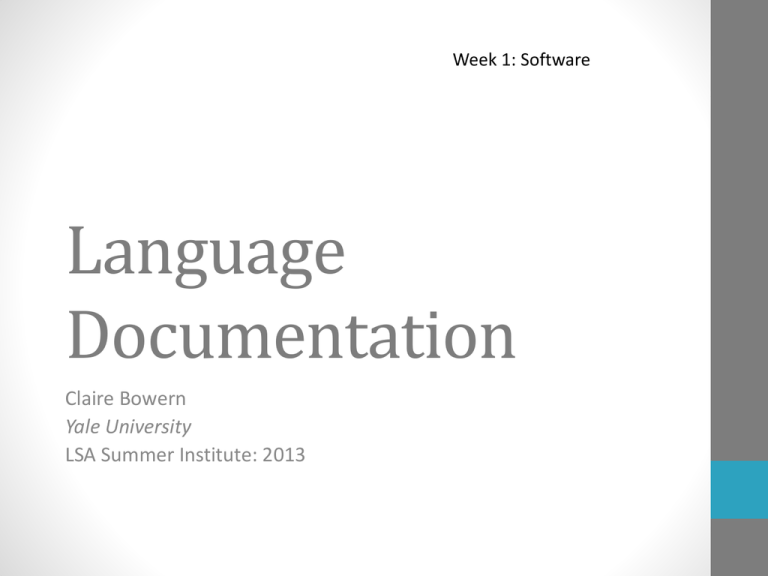
Week 1: Software Language Documentation Claire Bowern Yale University LSA Summer Institute: 2013 GENERAL PRINCIPLES General Principles • “Interoperability”: aka “never need to retype!” • Ideally, it should be possible to move data easily and seamlessly between programs (or use a single program for everything). • In reality… • The ‘single program’ solution produces unacceptable compromises (bloatware, can’t handle all data types, etc) • Multiple programs require the programmers to agree on data standards, which will never happen. • Several programs now solve *most* of the problems. • Workarounds are possible but require care. Choosing software • Ease of use with your data • How long will it take to learn the program? Is it worth it? • Can you type your language easily (e.g. right-to-left input, nonAscii symbols, etc)? • Can you keep track of all the information you need to? • Does the program work well within your workflow? • Can you search your data easily? • Can you get your data into and out of the program? Can you back it up? • Can other people use it? Do you need to share your data? Do you need to have more than one person working on your data? Today: SOFTWARE TYPES Software types • Each point of the workflow (i.e. each task in the documentation) will need certain software • • • • Creation [and editing] Annotation [and analysis] Preservation Dissemination [and publication] Overview of programs by function • • • • • • • • Organize field notes and recordings Process recordings (audio and video) Transcription Corpus creation Parsing/interlinearization Analysis/tagging Lexicon/dictionary making Writing other secondary materials • journal articles • reference grammar, dissertation • community materials • Web publication • Backup tools Organizing field notes/recordings • Some way of recording what is on each recording, what you have in the collection • Needed for archiving • *Very* helpful for when you’re working with your collection. • Database program. • Filemaker, Bento • Access • Base, etc • Other options: • • • • • spreadsheet program like Excel or Base. Notetaking software such as Evernote Metadata tool such as IMDI iTunes Metadata extractor that takes collections and lets you annotate the file names. Sample Filemaker db Not recommended • Using the file name annotation in Apple finder, etc Information to collect • Session info • who, what, when, where, how • language • Speaker info • demographic info • Media info • sampling rate, etc • Material status info • access restrictions, processing comments, links Processing recordings • • • • • • Audio and video editing software. Resampling changing format (e.g. wav > mp3) clipping Audacity is popular. Praat can also do all the needed things (but can be cumbersome) • Quicktime or VLC for video conversions and clipping • (other video editing suites) Transcription • Elan (de facto standard?) (http://tla.mpi.nl/tools/tlatools/elan/) • Transcriber (http://transag.sourceforge.net/) • Transana (http://www.transana.org/) • Clan (used for the Childes database and talkbank) (http://childes.psy.cmu.edu/clan/) • Time-aligned transcripts should be mandatory! Elan example Corpus creation, management, and searching • aka: some way to organize your electronic fieldnotes and transcripts. • Toolbox, Elan • TLex has a corpus option, based on text files • TextStat (http://neon.niederlandistik.fuberlin.de/en/textstat/) Parsing/Interlinearization • Most commonly used platforms: • Toolbox • Flex • See http://tla.mpi.nl/tools2/tooltype/interlinearization/ for a great list of options. • Elan can be set up to parse semi-manually. • Lingsync (https://www.lingsync.org) Toolbox pros and cons • works on text files with minimal markup • well established in the field • can build lexicon • basic corpus tools • can interface with Elan • small footprint • files are sharable through e.g. dropbox • flat file database structure • Elan interface requires some hand-processing of texts (or knowledge of python) • parser doesn’t work well for complex morphology, tone • no ‘on the fly’ update • mac use is fiddly Flex Pros and Cons • Structured data entry • on the fly update • built-in analysis libraries (e.g. dictionary topics, morpheme types) • Slow! Bloatware! • Windows only • File sharing difficult • built-in analysis libraries encourage paint-by-numbers documentation. Summary: Data analysis • (Depends on the data and task) • Praat for phonetics (www.praat.org) • Corpus program, concordance generator (*very* useful!) • Toolbox • FLEx • TextStat • Some way of keeping track of notes, analyses, etc • e.g. Evernote • http://en.wikipedia.org/wiki/Comparison_of_notetaking_softwar e has a very long list of options. • Tiddlywiki • (Text editor, e.g. Textwrangler, NotePad++, etc) Dictionary • Lexique Pro (www.lexiquepro.com) • Toolbox or FLEx • For combining with texts, parsing, etc • Kirrkirr • Great for presenting final dictionaries • Not an editing program • TshwaneLex (tschwanedje.com) • For editing and printing/sharing dictionaries (not free) • WeSay (wesay.org) • (Lexus) Pros and Cons: Lexique • Widely used • Can edit entries easily • Can add pictures and sound • Can sort by meaning • English or Language list • Easy to update • Can publish on internet • Can use with Toolbox • Tends to crash • Doesn’t always work • Limited display • No fuzzy searching • Linking is temperamental • PC only • hard to have multiple users • hard to create fully bilingual dictionaries Pros and Cons: TshwaneLex • • • • Flexible/customizable Reliable PC and Mac Can include images and sound • Multiple exports • Can import corpus data • can create fully bilingual dictionaries • not free • steep learning curve • Mac version has some bugs • can’t use same file for interlinearization Pros and Cons: FLEx • Powerful • Free • Can integrate with written corpus • Can export to web, lexique, etc • PC only • Clunky, slow • Can’t integrate sound file transcriptions • Only one dictionary model • Lots of assumptions about linguistics built in • Difficult to export in multiple formats (via \ code) Software suggestions • Toolbox (or Flex or Lexique) • TshwaneLex if making a stand-alone dictionary • Transcription software (e.g. Elan) • a text editor (e.g. textwrangler [osx], edit pad [pc], etc) • Concordance program (textstat, monoconc, etc) Sample workflow • Transcribe with Elan • Export clips to Praat using sendpraat • preliminary annotation in Elan • Export to Toolbox • interlinearize • compile lexical materials • (annotate for analysis within file) • Reimport transcripts to Elan • Use Elan for corpus search • Export to web via CuPed • Pros: • Relatively streamlined • Requires few programs • Exploits advantages of each program • can be done offline • portable/can be backed up easily • flexible to export to other formats if needed • Cons: • potential version control issues What about using Word & Excel? Pros: • No learning curve • May be the most available software • May already have data Cons: Proprietary Designed for business, not for dictionary writing Word – no explicit structure Word – hard to search Excel – “flat” format, not relational Multiple people can’t work on same document Disseminating results • Many possibilities, depending on the type of results: • Word processing software for journal articles, dissertation, etc: • Word, LyX, (Xe)LaTeX • Desktop publishing software for school books, etc (e.g. indesign) • CuPED for sharing Elan transcripts. • Web editing software • App authoring software • Wunderkammer for mobile phone dictionaries • Google earth for site mapping • etc. Backing up your data • Cloud solutions • • • • • Dropbox Sugarsync Google Drive mac.com etc • University backup services • Physical media • portable hard drive • DVDs • -> Send to archive Cloud services • Pros: • Cheap (often free) • “set and forget”: can work with existing directory structures • Cons: • • • • Requires internet connection Might be difficult if you’re backing up audio and video Not necessarily secure Syncing issues: easy to overwrite data, not always easy to get it back. • If something happens to the service provider, you’re screwed. Physical media • Pros • Solves many of the ‘cons’ of cloud services • Cons • Unknown durability • time-consuming • Doesn’t solve the problem of physical destruction of data if kept in the same place as your main working copies! Archiving • Archive your original recordings as soon as possible! • You don’t need to finish analysis before archiving part of the collection. • More about archiving in week 4. Recommendations • Cloud based back up for analysis files, frequently access files. • Have at least one (ideally two or more) physical backups of all your data, stored in different places (e.g. one at home, one with your parents, one in the community) • Archive materials as soon as possible. • Sound like overkill? Causes of Data Loss
